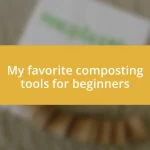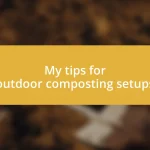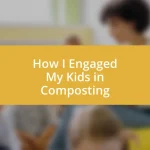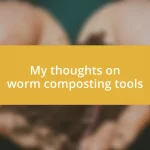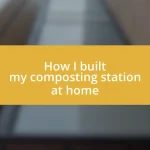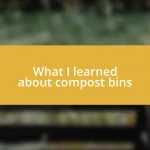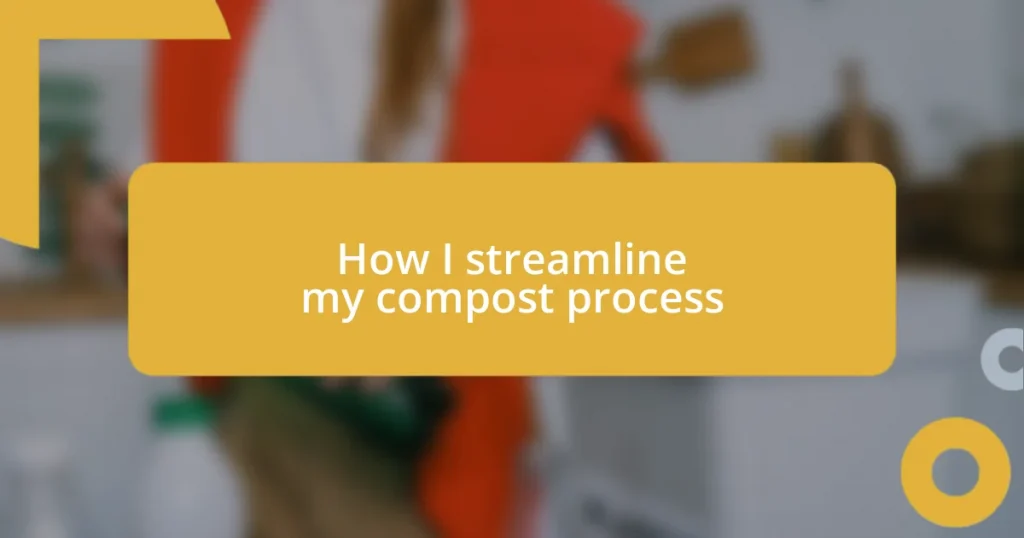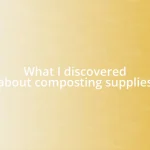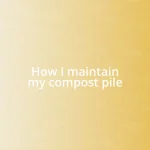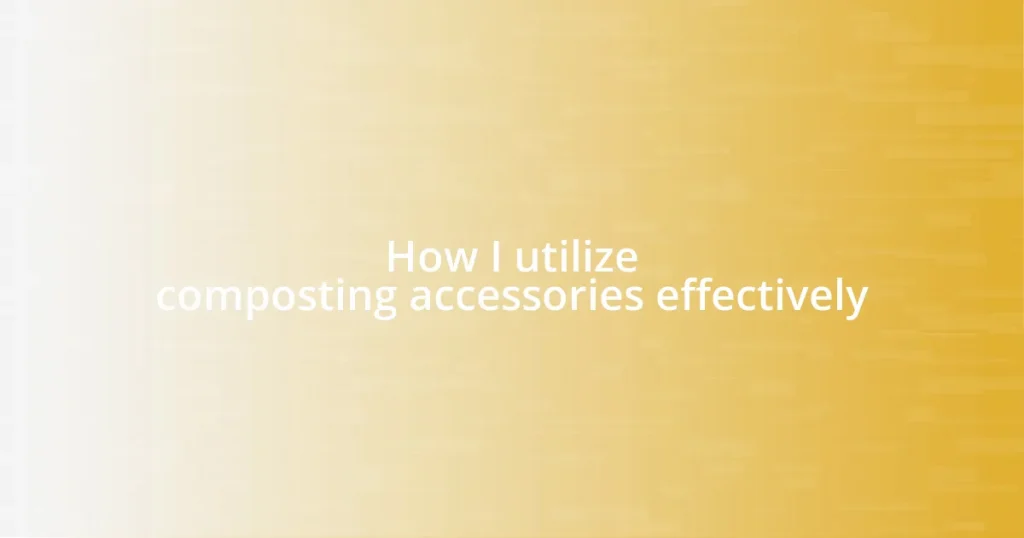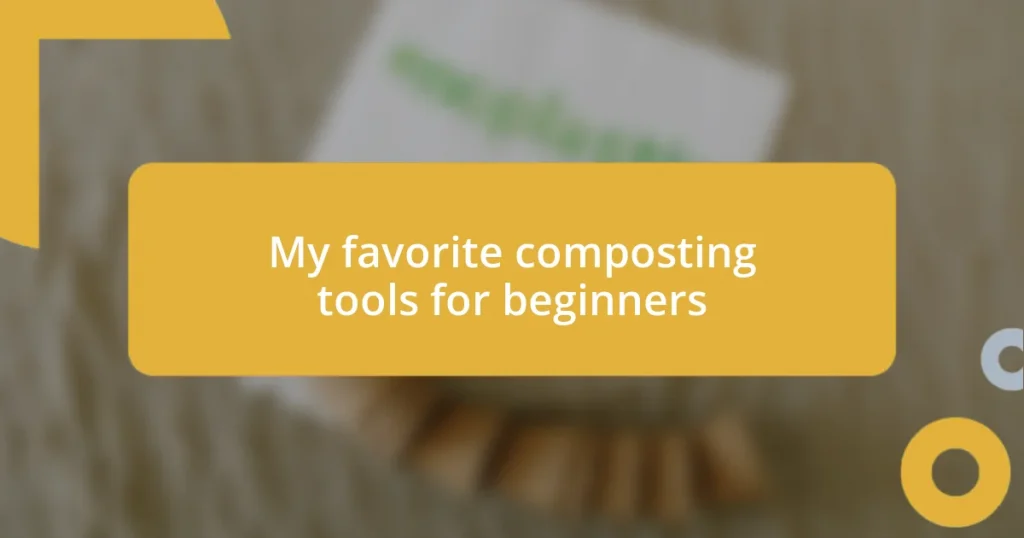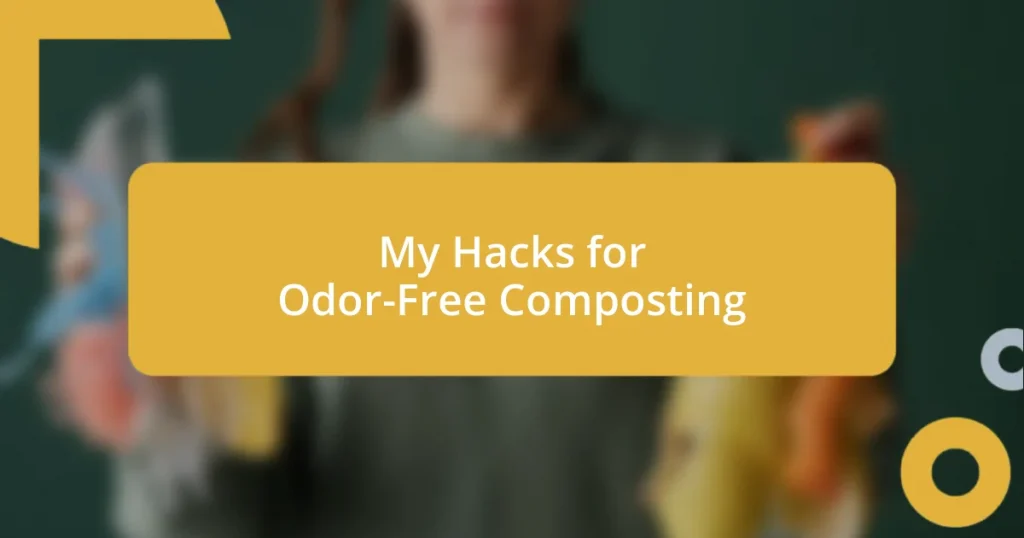Key takeaways:
- Maintaining a balance of “greens” (nitrogen-rich) and “browns” (carbon-rich) materials is crucial for effective composting, ensuring proper aeration and moisture levels.
- Preparation of compost materials, including chopping larger items and organizing scraps, accelerates decomposition and enhances the overall composting process.
- Key signs of successful compost include an earthy smell, dark crumbly texture, and the absence of recognizable scraps, indicating that microorganisms are effectively transforming waste into nutrient-rich compost.

Understanding composting fundamentals
Composting is essentially nature’s recycling system, transforming organic waste into enriched soil. I remember the first time I dug into my compost pile and found rich, dark soil. It felt like a little treasure trove, and I had a hard time believing that such valuable material could emerge from kitchen scraps and garden debris!
At its core, composting relies on a balance of “greens” and “browns.” Greens, like fruit scraps and grass clippings, are rich in nitrogen, while browns, such as dried leaves and cardboard, provide carbon. Have you ever wondered why some compost piles work better than others? I certainly have! It often comes down to this balance and considering the microorganisms at work, breaking everything down into nutrient-rich compost.
Maintaining that balance is a dynamic process. I often find myself adjusting based on what I have available. When I first started composting, I was surprised by how quickly things can go wrong—like when my pile became too compacted and anaerobic. That’s when I realized that regularly turning the pile and ensuring proper aeration is vital for successful composting. It’s truly an art form!

Choosing the right compost materials
When it comes to choosing the right compost materials, I’ve learned that variety is key. I often find myself experimenting with different kitchen scraps, garden trimmings, and even the occasional shredded paper. It’s fascinating to see how ingredients like coffee grounds and eggshells can really kickstart the composting process, bringing in those necessary nutrients for the final product. Thinking of starting a compost pile? Consider what you often throw away because it can transform into something valuable for your garden!
I also pay close attention to the size of my compost materials. Smaller pieces break down faster, so I deliberately chop up larger branches or tear up cardboard. This might seem like a step that could be overlooked, but I swear, I’ve witnessed firsthand how a little extra effort in preparation pays off in the long run. One day, after adding some chopped-up leaves and kitchen scraps, I noticed the temperature in my pile spike—indicating active decomposition! That was such an exhilarating moment, showing me just how dynamic my compost could be!
Looking at the right ratio of greens to browns is essential. It might take some practice, but I like to think of it as a recipe—add a handful of greens, followed by an ample layer of browns. Striking the right balance makes all the difference in how well your compost breaks down. I recall one season when too many grass clippings made my pile uneven, leading to a slimy mess. I’ve learned to keep a close eye on that ratio and adjust accordingly, making my compost experience a successful one.
| Greens (Nitrogen-rich) | Browns (Carbon-rich) |
|---|---|
| Fruit scraps | Dried leaves |
| Vegetable peels | Cardboard |
| Grass clippings | Sawdust |
| Coffee grounds | Shredded paper |

Preparing materials for composting
When preparing materials for composting, I find that organization makes the entire process smoother. I often gather my kitchen scraps and yard waste in designated containers. For instance, I keep a small bin under the sink specifically for vegetable peels and fruit cores. It’s such a satisfying routine, knowing that what I once deemed waste is now a resource for my garden!
Here’s a quick checklist of items to consider as you prepare your materials:
- Rinse out any oils from food containers to prevent attracting pests.
- Separate meat and dairy scraps, which can attract unwanted critters.
- Aim to keep your browns and greens visible in your compost bin, making it easy to maintain balance.
- Avoid adding any diseased plants or invasive weeds that may disrupt your compost’s integrity.
I can’t help but chuckle at my early composting days when I tossed everything together without a second thought! Learning to prep my materials has been a game changer. Not only does it speed up decomposition, but I also take pride in the way my composting process has evolved into a more thoughtful practice. Seeing the vibrant soil emerge from my carefully prepared layers feels like a personal victory, a reminder that even the smallest changes can lead to remarkable results.

Tips for maintaining compost health
Maintaining a healthy compost pile is like nurturing a living ecosystem; every little detail matters. One tip I swear by is monitoring moisture levels. I’ve learned the hard way that a compost pile that’s too dry becomes a sluggish mess, while one that’s overly wet can end up smelling like a swamp. A quick tip is to squeeze a handful of compost—if water drips out, it’s too wet; if it crumbles, it’s perfect. It’s become second nature for me to check this each time I add new materials.
Turning your compost regularly is another crucial step. I remember the first time I turned my pile—I practically stumbled upon the treasure of beautiful, crumbly soil beneath. It not only aerates the mixture but also helps speed up decomposition by ensuring that everything breaks down evenly. I try to turn my compost every couple of weeks, which also feels like a mini workout and a chance to connect with my garden. Who knew that tending to my compost could double as exercise?
Lastly, think about the temperature of your compost pile; it’s a tell-tale sign of its health. I often take a moment to check the warmth with my hand. If it’s steaming, I’m thrilled to know the microbes are doing their job! However, if it’s cool, it might be time to add more greens or turn it. It’s like a conversation with the compost—understanding its needs helps me stay on track. This connection makes me feel more invested in the outcome, knowing that I’m part of a fantastic recycling process. How empowering is that?

Signs of successful compost
One of the most telling signs of successful compost is the earthy smell that wafts up when you turn the pile. I still remember the first time I caught a whiff of that rich aroma; it felt like a badge of honor. It’s a reminder that all those kitchen scraps and yard clippings are breaking down into something valuable rather than just rotting away. Can you sense the magic in the air?
When you dig into your compost and find a dark, crumbly texture that resembles rich soil, that’s the ultimate success indicator. The first time I unveiled my finished compost, I was genuinely giddy! It felt like uncovering treasure after months of diligent care. This is exactly what you want to see—it means those microorganisms have been hard at work, transforming what once was waste into nutrient-dense gold for your garden.
Another sign is the absence of recognizable scraps. If you can’t identify what you put in a few weeks ago, congratulations! I recall feeling a mix of disbelief and excitement when I realized just how quickly things were breaking down. It’s like a magic trick where your leftovers vanish and turn into something life-giving. That’s when I knew my compost process was really working, and it affirmed the joy of creating a sustainable cycle right in my backyard.

Using compost in gardening
When I first started using compost in my garden, it felt like unlocking a secret weapon for plant growth. I remember vividly the moment I sprinkled homemade compost around my tomato plants. The rich, dark mix seemed to breathe new life into them almost instantly. It’s like giving your plants a gourmet meal instead of the bland stuff from a store. Have you ever seen a plant perk up with joy? It’s a rewarding sight!
In my experience, incorporating compost not only improves soil structure but also enhances its fertility. I often mix it directly into my raised beds each spring, and the difference is palpable. What’s fascinating is how my plants respond—lush green leaves and vibrant blooms that almost seem to compete for attention. As I dig into the soil, I can feel the texture has changed, becoming crumbly and alive with microbial activity. Don’t you just love that earthy feeling in your hands?
Another benefit I’ve noticed is how compost acts as a natural fertilizer, reducing the need for synthetic options. When my friend tried composting for the first time and shared her garden’s transformation, it reaffirmed my belief in this method. She saw her zucchini plants flourish like never before, and every time she harvested a batch, it felt like a community achievement! Knowing I can nourish my plants while also improving the ecosystem? That truly fuels my passion for gardening. How thrilling is that notion?

Troubleshooting common compost issues
Sometimes, your compost may smell foul instead of the pleasant, earthy scent we all love. This happened to me once when I let my pile get too wet and too green; it was as if I had created a swamp instead of a compost haven. If you ever find yourself in a similar situation, try adding more browns like dried leaves or cardboard to balance the green materials, and give it a good turn to aerate the pile. Have you ever jumped into action after a smell that was less than appealing? It’s a wake-up call for any compost enthusiast!
Another issue that can arise is the presence of pests, which can be disheartening. I recall a time when I noticed fruit flies buzzing around my compost. At first, I panicked, fearing I’d invited a swarm into my garden. However, I learned I could cover my scraps with browns, which acts like a protective layer and keeps those pesky visitors at bay. Isn’t it fascinating how such simple adjustments can create harmony in your compost ecosystem?
Lastly, a slow decomposition process can be frustrating, especially when you’re excited to harvest that rich compost. I once waited what felt like an eternity only to find my pile sitting stagnant. After a bit of research, I discovered that chopping up larger pieces leads to quicker breakdowns. Now, I use a garden shredder, and the difference is remarkable! Have you noticed how small changes can make a huge impact? Transforming my composting experience has truly been an adventure, and it’s all in the little tweaks we make along the way.

